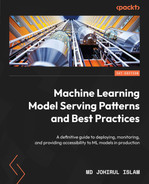Become a successful machine learning professional by effortlessly deploying machine learning models to production and implementing cloud-based machine learning models for widespread organizational use Serving patterns enable data science and ML teams to bring their models to production. Most ML models are not deployed for consumers, so ML engineers need to know the critical steps for how to serve an ML model.
This book will cover the whole process, from the basic concepts like stateful and stateless serving to the advantages and challenges of each. Batch, real-time, and continuous model serving techniques will also be covered in detail. Later chapters will give detailed examples of keyed prediction techniques and ensemble patterns. Valuable associated technologies like TensorFlow severing, BentoML, and RayServe will also be discussed, making sure that you have a good understanding of the most important methods and techniques in model serving. Later, you’ll cover topics such as monitoring and performance optimization, as well as strategies for managing model drift and handling updates and versioning. The book will provide practical guidance and best practices for ensuring that your model serving pipeline is robust, scalable, and reliable. Additionally, this book will explore the use of cloud-based platforms and services for model serving using AWS SageMaker with the help of detailed examples.
By the end of this book, you'll be able to save and serve your model using state-of-the-art techniques. This book is for machine learning engineers and data scientists who want to bring their models into production. Those who are familiar with machine learning and have experience of using machine learning techniques but are looking for options and strategies to bring their models to production will find great value in this book. Working knowledge of Python programming is a must to get started.Key Features
Book Description
What you will learn
Who this book is for
Table of Contents
- Machine Learning Model Serving Patterns and Best Practices
- Contributors
- About the author
- About the reviewer
- Preface
- Part 1:Introduction to Model Serving
- Chapter 1: Introducing Model Serving
- Chapter 2: Introducing Model Serving Patterns
- Part 2:Patterns and Best Practices of Model Serving
- Chapter 3: Stateless Model Serving
- Chapter 4: Continuous Model Evaluation
- Chapter 5: Keyed Prediction
- Chapter 6: Batch Model Serving
- Chapter 7: Online Learning Model Serving
- Chapter 8: Two-Phase Model Serving
- Chapter 9: Pipeline Pattern Model Serving
- Chapter 10: Ensemble Model Serving Pattern
- Chapter 11: Business Logic Pattern
- Part 3:Introduction to Tools for Model Serving
- Chapter 12: Exploring TensorFlow Serving
- Chapter 13: Using Ray Serve
- Chapter 14: Using BentoML
- Part 4:Exploring Cloud Solutions
- Chapter 15: Serving ML Models using a Fully Managed AWS Sagemaker Cloud Solution
- Index
- Other Books You May Enjoy
